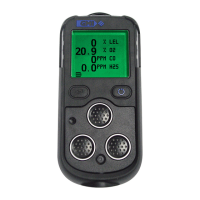
Do you have a question about the 3M GMI PS200 Series and is the answer not in the manual?
| Brand | 3M |
|---|---|
| Model | GMI PS200 Series |
| Category | Measuring Instruments |
| Language | English |
Explains visual elements like WARNING, CAUTION, and NOTE icons.
Lists the monitor's certifications and approvals from various bodies.
Provides essential safety warnings and guidelines for monitor usage.
Presents specific safety cautions related to CSA standards.
Overview of the PS200 monitor's design, capabilities, and applications.
Lists the key features and functionalities of the portable gas monitor.
Details the data logging capabilities, storage, and data access.
Explains the function and importance of the monitor's filters.
Step-by-step guide for pre-use checks and initial operation.
How to view monitor configuration settings before full power-up.
Safe procedures for powering on the gas monitor.
Manual control for the LCD display's backlight.
Accessing recorded maximum, minimum, STEL, and LTEL gas values.
Instructions for manually saving current gas readings.
Procedures for managing and acknowledging monitor alarms.
Performing a self-test to verify monitor functionality.
Safe procedures for powering off the gas monitor.
General overview of gas alarm types, levels, and configuration.
How to clear active gas alarms after conditions return to safe levels.
How to temporarily silence audible alarms.
Warning and indication for high flammable gas concentrations.
Warning and indicators for low battery status.
Warning and indicators for a battery fault.
Explanation of zero fault conditions during warm-up.
General information and specific fault types for sensors.
Warning and troubleshooting for flow faults in pumped models.
Indication and action for when monitor calibration is overdue.
Explains the purpose, types, and importance of bump tests.
Step-by-step instructions to start a manual bump test.
Procedure for correctly applying test gas during a bump test.
Details on the differences between Quick and Full bump tests.
Prompt to verify if alarms activated during a bump test.
General warnings and conditions for safe battery recharging.
Step-by-step guide to recharging the monitor via the clip.
Instructions on how to clean the monitor safely and effectively.
Information on the monitor's filters and their replacement.
Detailed steps for replacing the hydrophobic filter.
Detailed steps for replacing the sample inlet (dust) filter.
Overview of calibration requirements and authorized personnel.
Step-by-step procedure for performing a quick calibration.
Emphasizes user responsibility for maintaining calibration validity.
List of accessories included with the monitor.
List of optional accessories available for purchase.
List of accessories for recharging the monitor.
Details of manual bump and field calibration kits.
Details of automatic bump and calibration accessories.
Table of typical operating parameters for the monitor.
Comparison of different LEL sensor types and their capabilities.
